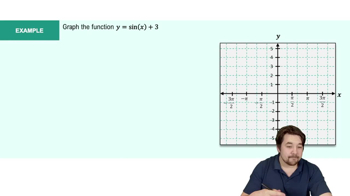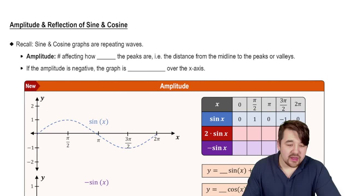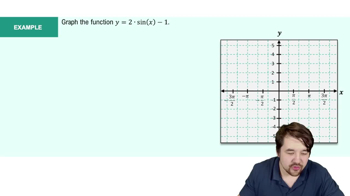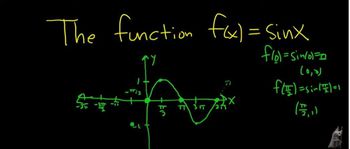Table of contents
- 0. Review of College Algebra4h 43m
- 1. Measuring Angles39m
- 2. Trigonometric Functions on Right Triangles2h 5m
- 3. Unit Circle1h 19m
- 4. Graphing Trigonometric Functions1h 19m
- 5. Inverse Trigonometric Functions and Basic Trigonometric Equations1h 41m
- 6. Trigonometric Identities and More Equations2h 34m
- 7. Non-Right Triangles1h 38m
- 8. Vectors2h 25m
- 9. Polar Equations2h 5m
- 10. Parametric Equations1h 6m
- 11. Graphing Complex Numbers1h 7m
4. Graphing Trigonometric Functions
Graphs of the Sine and Cosine Functions
Problem 77a
Textbook Question
Graph each function. See Examples 6 – 8. _ ƒ(x) = 2√x + 1
 Verified step by step guidance
Verified step by step guidance1
Identify the basic function: The function \( f(x) = 2\sqrt{x} + 1 \) is a transformation of the square root function \( \sqrt{x} \).
Determine the transformations: The function \( 2\sqrt{x} + 1 \) involves a vertical stretch by a factor of 2 and a vertical shift upwards by 1 unit.
Find the domain: Since the square root function is only defined for non-negative values, the domain of \( f(x) \) is \( x \geq 0 \).
Plot key points: Calculate a few key points by substituting values of \( x \) into the function, such as \( x = 0, 1, 4 \), to find corresponding \( f(x) \) values.
Sketch the graph: Use the key points and transformations to sketch the graph, starting from the origin and following the shape of the square root function, stretched and shifted as determined.
Recommended similar problem, with video answer:
 Verified Solution
Verified SolutionThis video solution was recommended by our tutors as helpful for the problem above
Video duration:
2mPlay a video:
Was this helpful?
Key Concepts
Here are the essential concepts you must grasp in order to answer the question correctly.
Square Root Function
The square root function, denoted as √x, is defined for non-negative values of x and produces the principal square root. It is a fundamental function in mathematics, characterized by its gradual increase and a domain of [0, ∞). Understanding its properties, such as its shape and behavior, is essential for graphing functions that involve square roots.
Recommended video:

Imaginary Roots with the Square Root Property
Transformation of Functions
Transformations of functions involve shifting, stretching, or compressing the graph of a function. In the given function ƒ(x) = 2√x + 1, the '2' indicates a vertical stretch by a factor of 2, while the '+1' represents a vertical shift upward by 1 unit. Recognizing these transformations helps in accurately graphing the function based on its parent function.
Recommended video:

Domain and Range of Function Transformations
Domain and Range
The domain of a function refers to the set of all possible input values (x-values), while the range is the set of all possible output values (y-values). For the function ƒ(x) = 2√x + 1, the domain is [0, ∞) since square roots are only defined for non-negative numbers, and the range is [1, ∞) due to the vertical shift. Understanding domain and range is crucial for graphing and interpreting functions.
Recommended video:

Domain and Range of Function Transformations

 5:53m
5:53mWatch next
Master Graph of Sine and Cosine Function with a bite sized video explanation from Nick Kaneko
Start learningRelated Videos
Related Practice


















